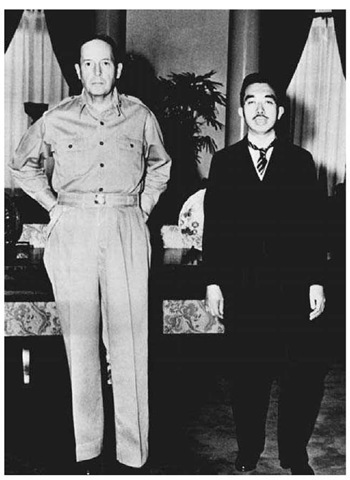Postwar Japan was officially in the hands of the United States, Great Britain, the Soviet Union, and China. However, aside from a small British contingent, only the United States provided occupation troops, and though the other powers were consulted, the United States made almost all of the decisions for occupied Japan.
The primary man in charge was General Douglas MacArthur (1880-1964), who, as supreme commander for the Allied powers, directed the rebuilding and restructuring of postwar Japan. The first order of business was dealing with the immediate aftermath of the war. What remained of the Japanese military was disbanded, and, as with Germany, some Japanese leaders were tried for war crimes. Thousands of these trials were held in areas such as Japan, Singapore, Philippines, and Hong Kong, but trials for those accused of the worst crimes were held in Japan. Twenty-five people were put on trial for the most severe crimes, deemed Class A. All were found guilty of at least some of the charges. Seven of them, including General Hideki Tojo (1884-1948), head of the army and prime minister throughout much of the war, and former Prime Minister Koki Hirota (1878-1948), were executed.
The focus then shifted to rebuilding and restructuring Japan. Almost all of Japan’s major cities were destroyed, along with the country’s infrastructure; this had to be rebuilt if Japan’s economy could return to strength. It was also decided that many of the large corporations (zaibatsu) that had controlled the prewar economy were to be dissolved. This decision was not made primarily for economic reasons, but because these large entities had opposed democracy, the implementation of which was a primary goal of the occupation.
Japanese society also faced reforms, primarily intended to foster a new democratic ideal. A primary concern for the Americans was the Japanese education system. If democracy was to take hold in a country that for so long had been governed by different ideals, it must be fostered among the youth of Japan. The reforms included a careful monitoring of textbooks, the adoption of the American system of progression through the years, and the decentralizing of the entire education system.
MacArthur and Hirohito in Tokyo. General Douglas MacArthur stands with Hirohito, Japan s wartime emperor, in the U.S. Embassy in Tokyo on September 27, 1945. Hirohito found a great ally in MacArthur, who believed that the retention of Hirohito himself, and not merely the office of emperor, was essential for the successful rebuilding of Japan.
The Japanese concept of Shinto was declared a religion, and was separated from the state. Following the tenants of state Shinto, the Japanese saw it as a duty to revere what they believed was their divine emperor. The question of what to do with the emperor was the most difficult for the Americans. Most in the American government wanted Japan to retain the office of emperor, but without the divine status that the position held before the war. The main reason given for retaining the emperor was that he could bring stability to Japan, which the Americans believed would help prevent the spread of communism to Japan.
As for Hirohito (1901-1989), Japan’s wartime emperor, more than a few Americans in high office believed he should be removed or even put on trial for war crimes. But Hirohito found a great ally in MacArthur, who consistently told his superiors that the retention of Hirohito himself, and not merely the office of emperor, was essential for the successful occupation and rebuilding of Japan.
The most significant of the reforms put into place was Japan’s new constitution, which remains virtually unaltered to this day. The constitution, agreed upon in early 1946, guaranteed specific freedoms, civil liberties, and a democratic government; the constitution also officially ended Shinto as the state religion, and established a new role for the emperor. However, the most noticed, and later the most controversial, part of the constitution was Article IX. With this article Japan declared that it would never again go to war and that as a state it had no right to belligerent actions. Hence, Japan would be allowed no military forces.
The end of the occupation of Japan was initiated with the signing of the San Francisco Peace Treaty on September 8, 1951, and became official on April 28, 1952. Though the official occupation was ended, U.S. troops have remained in Japan for decades. This occurred, in part, because of Cold War considerations, but also because of Japan’s new constitution—without its own military forces, Japan would have to be protected.
In Japan’s government, party politics quickly became dominated by the Liberal Democratic Party. Japanese culture also began to find its way to different parts of the world, thanks in part to returning American soldiers who brought with them stories and small physical reminders from Japan. The post-occupation period coincided with a significant growth in world interest in Japanese movies, cartoons, comic books, and, to lesser degree, martial arts.
As the decades passed, Japan continued to experience unprecedented economic growth. Consumer products, especially electronics and automobiles, soon became the staple of Japan’s economy. The 1980s and the 1990s established Japan as an economic powerhouse. However, some believed that this growth occurred in part because Japan had an unfair advantage. Though Japan created a self-defense force after the occupation, it still relied primarily on the United States for protection. Thus, Japan expended less of its gross domestic product for defense than almost any other industrialized country. Most experts believe the lack of this economic burden was a contributing factor to Japan’s success.

